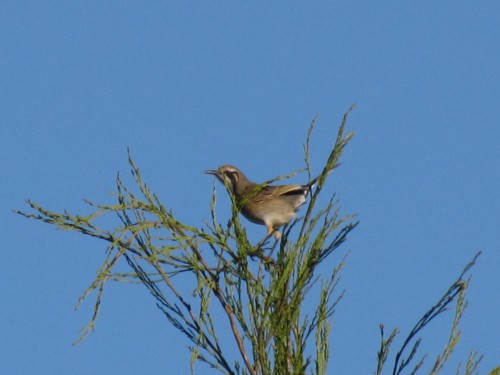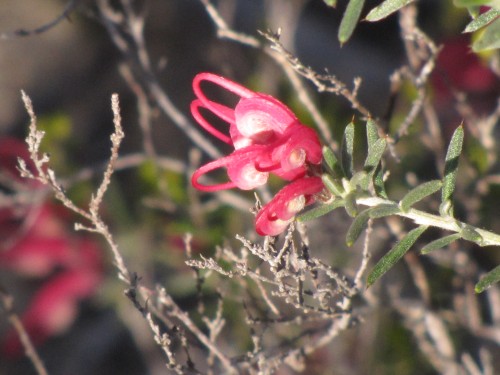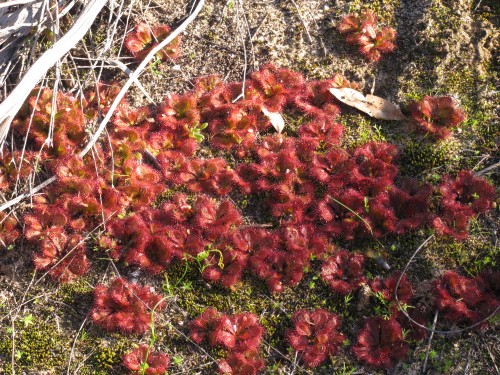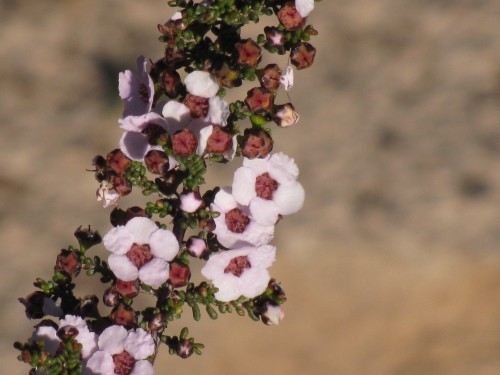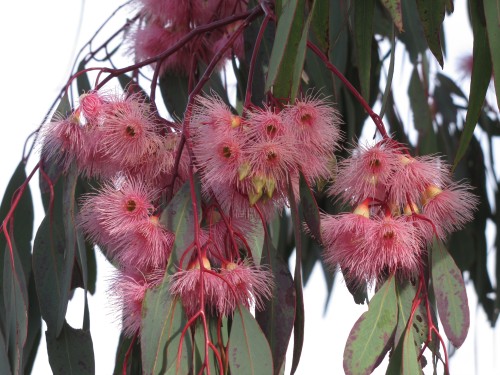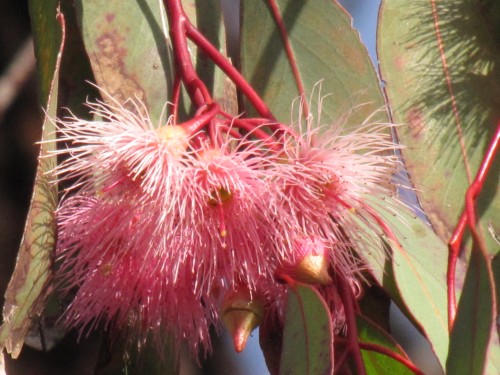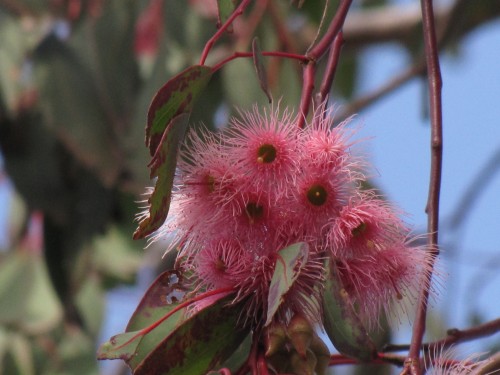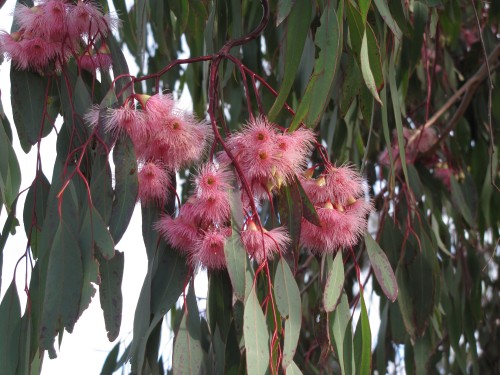Tawny-crowned Honeyeater at Monarto CP
A few days ago my wife and I took advantage of a lovely sunny winter’s day. We’ve had some very gloomy overcast weather in the last month or so, and some sunshine was an event to celebrate. We went for a drive to Monarto Conservation Park which is about a 15 minute drive from our home in Murray Bridge. Monarto CP is about 60km south east of Adelaide in South Australia.
Mind you, the sun may have been shining, and there were no clouds in the sky, and we were well rugged up, but the breeze was still chilly. Never mind, we packed the folding chairs, a Thermos of hot water, some tea bags and some biscuits for afternoon tea. We were prepared.
Before indulging in our treats we went on the walking trail through the park. This is an easy, almost level sandy track through several different habitats. Despite the recent poor weather we were delighted to see so many native plants in flower. I have included a few photos below. While my wife has a good working knowledge of our native birds, her main interest is in the native plants (you can read about her interest on her site here).
I have found over the years that birding in the Monarto Conservation Park can be rather hit or miss. Sometimes the birds can be singing and busily feeding and flying around. On other occasions the bird life can be quiet and inactive. Much of this is due to two main factors: weather conditions and what is flowering.
On this occasion there seemed to be a great deal of activity but, wouldn’t you know it – the birds were not showing themselves all that much. In fact, I only managed reasonable – certainly not brilliant – photos of one species: the Tawny-crowned Honeyeater as shown in the photo above. I should be pleased; the photos taken were the first I have managed of this species.
This honeyeater is a widespread species of southern Australia, from coastal NSW and Tasmania, much of Victoria, southern South Australia and south-western Western Australia. Its preferred habitats include mallee, heathlands, eucalyptus woodlands and street trees. It can easily be confused with the similar looking Crescent Honeyeater – which initially I did.
Further reading:
- Crescent Honeyeater
- An afternoon walk in Monarto Conservation Park
- Birds of Monarto Conservation Park
Bird list:
- Spiny-cheeked Honeyeater
- Red Wattlebird
- Mallee Ringneck parrot
- Silvereye
- Grey Shrike-thrush
- Australian Magpie
- Southern Scrub-robin
- Grey Currawong
- Weebill
- Grey Fantail
- New Holland Honeyeater
- Brown-headed Honeyeater
- Grey Butcherbird
- Tawny-crowned Honeyeater
- Little Raven
- Willie Watail
- Black-faced Cuckoo-shrike
- Shy heathwren
Mallee Fowl in the Murraylands region
Nearly 9 years ago I wrote the following article:
A few days ago I had a new comment on this post with an observation about the lack of Mallee Fowl in the park. Here is the comment:
I visited Ferries MacDonald CP on Tuesday 23 June and noticed that 1080 poison baits have been used to attempt to eradicate foxes. There were signs on the boundary fences warning dog owners. I did not see any mallee fowl despite spending several hours wandering through and around the park. I suspect there are none left unfortunately. I last visited the park thirty years ago and saw one there at that time as well as a few active nests. The park is not large and is surrounded by farmland. It may be too small to provide a suitable habitat for mallee fowl. I hope I am wrong. David.
The following was my reply:
As a result of your comments my wife and I briefly visited the park last Sunday. We actually spent more time in the nearby Monarto Conservation Park.
The poison baits programme has been ongoing for quite some time, probably years, and is a common practice in many parts of Australia. I have walked through both of these parks on numerous occasions over the last 30 years (I live in Murray Bridge) and have only ever seen Mallee Fowl on one occasion, two together on the side of the road near where the two roads intersect.
Last Sunday I checked on one of the Mallee fowl nest mounds that I have checked regularly since finding it some 10 years ago. It was active as recently as about 3 years ago, but sadly it now looks as if it hasn’t been used in at least the last two years, possibly longer. I know of at least 3 other mounds but I would be hard pressed to find them now. Extensive surveys of nesting sites have been conducted but I do not know when the last was done, nor the results.
On a related matter, national parks rangers were, I believe, removing eggs from the active nests, taking them to Monarto Zoo for hatching artificially and then returning the birds to the wild, including this park. Some birds were released with radio tracking devices and the failure rate was near to 100%, probably due to fox predation.
On a brighter note, a friend who lives less than a kilometre from the park saw a Mallee Fowl wandering through his garden only last year, so there is hope that some are surviving in this area. There are also regular reports of sightings east of the Murray River, and from the south east parts of the state.
Further reading:
- Ferries-McDonald Conservation Park – now updated with new information
- Mallee Fowl – the incubator bird
- What kind of duck was that? An exciting observation of Mallee Fowls
- Birds of Monarto Conservation Park
Red Wattlebirds and Eucalypts
Red Wattlebirds are one of the largest species of honeyeater in Australia. They are also one of the more common species of honeyeater over their range which is southern Australia.
The Red Wattlebird is a resident breeding species in our garden and on our five acre block of mallee scrub here in Murray Bridge, South Australia. We see them every day and we hear them calling throughout the day. During the warmer days they are frequent visitors to our bird baths, bullying most other species away from the water.
Over recent days we have been observing several wattlebirds feeding on the flowers of the Eucalyptus sideroxylon rosea tree in our drive-way. The common name of the tree is Red Iron-bark. I tried to get a photo of one of them feeding on the flowers but they always flew away before I could sneak up within camera range.
So – instead of getting frustrated by my lack of photos of the feeding birds, I have decided to show some photos of the flowers of the trees for your enjoyment.
Further reading:
